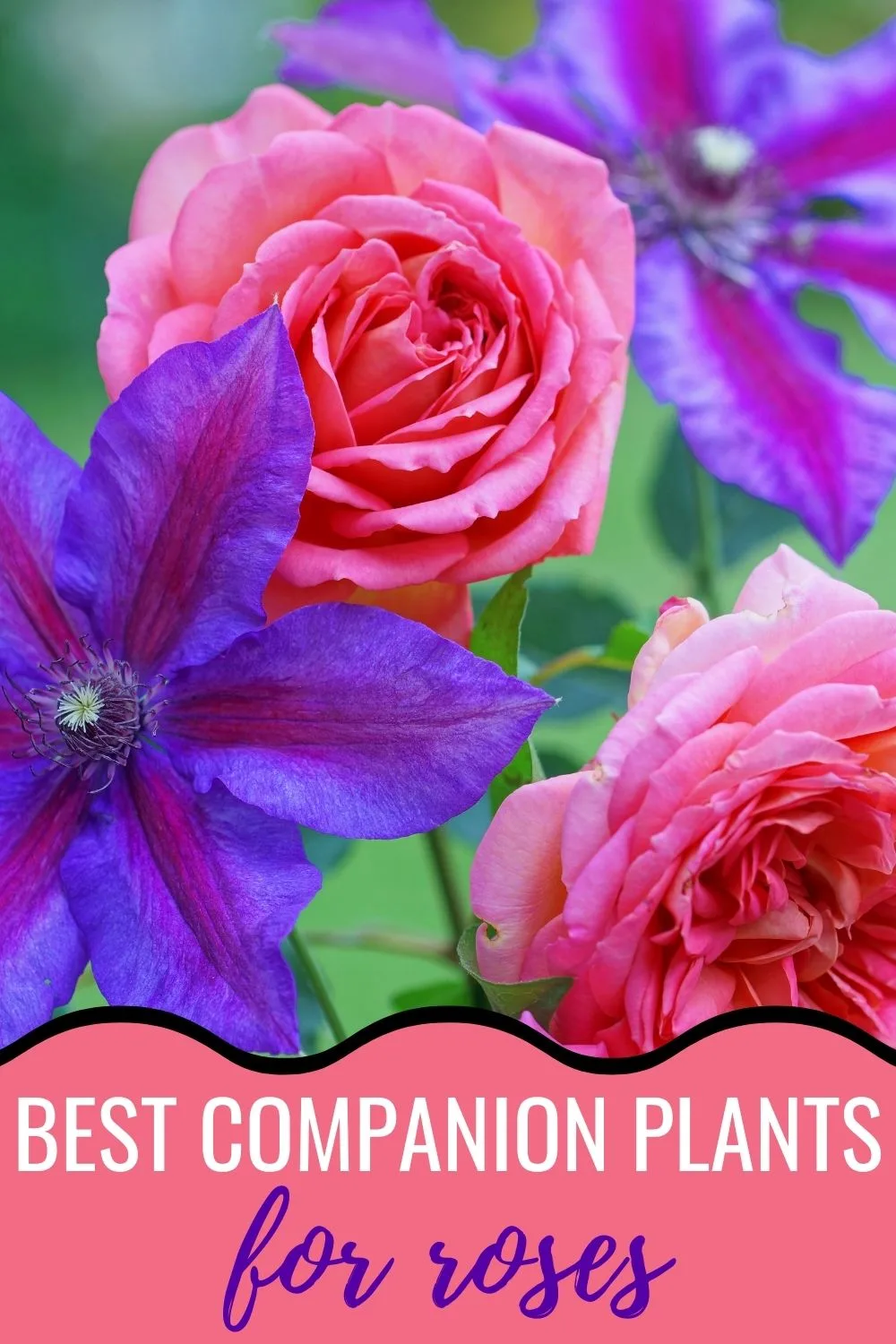Roses are a beautiful addition to any garden. But, they can be difficult to grow and maintain. Luckily, there are many plants that will help your roses thrive! Here are the best companion plants for roses to keep your rose garden healthy and looking good.
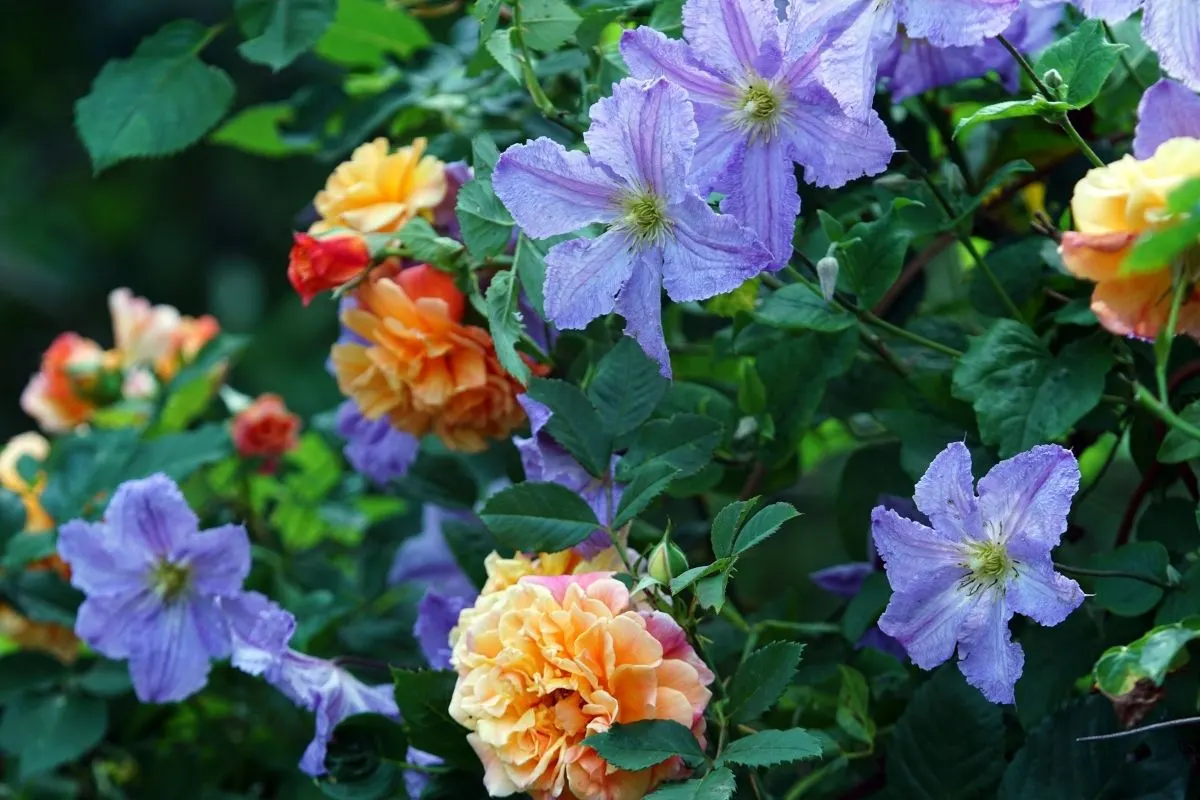
I’ve been growing roses for many years and have personally tested every combination I list in this article, including the ones that don’t work. But over my years of raising roses, I have found that companion planting has become more important every time I try a new rose.
Why? Because, for over 100 years, plant breeders have focused their efforts on perfecting the hybrid tea rose. Constant improvements in hybrid roses have taken us beyond traditional pink roses and yellows roses to blooms of just about every color except black and blue. They have given us rose bushes of exotic growth habits and foliage colors:
- sturdy stems
- high, centered buds
- brilliantly colored blooms that unfold into a multitude of petals delight the senses
But a century of focusing on floral beauty leaves rose gardeners with the same challenges. Roses insist on full sun. Both shrub roses and climbing roses need good air circulation to stave off disease.
Rose beds seem to be magnets for predictable insect pests.
Some of the most aesthetically pleasing choices for adjacent flower beds don’t make good companions for the roses that are the main attraction.
The downside of a century of real horticultural progress has been that roses have become fussy plants. They require constant protection from blackspot, Botrytis blight, stem cankers, mosaic virus, and rose rosette, not to mention attacks from aphids, beetles, stem cutter bees, spider mites, midge, and thrips.
Growing roses could become a full-time venture in spraying chemicals. But an organic approach works even for gardening with roses. Companion plants are an essential tool for organic rose gardeners, and a useful way to reduce the need for chemicals for gardeners who take a more conventional approach.
What Are Companion Plants?
Companion plants share a home in your garden. The function of a companion plant for your rose garden depends on whether your objective is to grow a rose garden or a garden with roses.
Some of the most spectacular roses deserve the spotlight. They become the visual focus of a rose garden. They benefit from lower-profile companion plants that protect them from disease. Ideally, these plants should provide color for the garden when roses are not in bloom.
Some roses are at their most beautiful with other flowers. They add their beauty to a garden with roses. These roses benefit from disease protection, too, but they also can share the spotlight with other flowering plants.
What Is the Best Companion Plant for Roses?
There is no single best companion plant for every rose in every season.
Different companion plants work well with roses at different times of the year.
Many roses are heavily pruned in late winter (learn about pruning drift roses) and are not particularly attractive before they leaf out again. Underplant them with a succession of flowers by planting some spring-blooming bulbs, such as tulips, crocus, narcissus, snowdrops, and grape hyacinths.
Here are some tips for creating a stunning rose flower garden.
Then consider these other plants for warm-season companion planting.
1. Ornamental alliums (as well as edible onions and garlic)
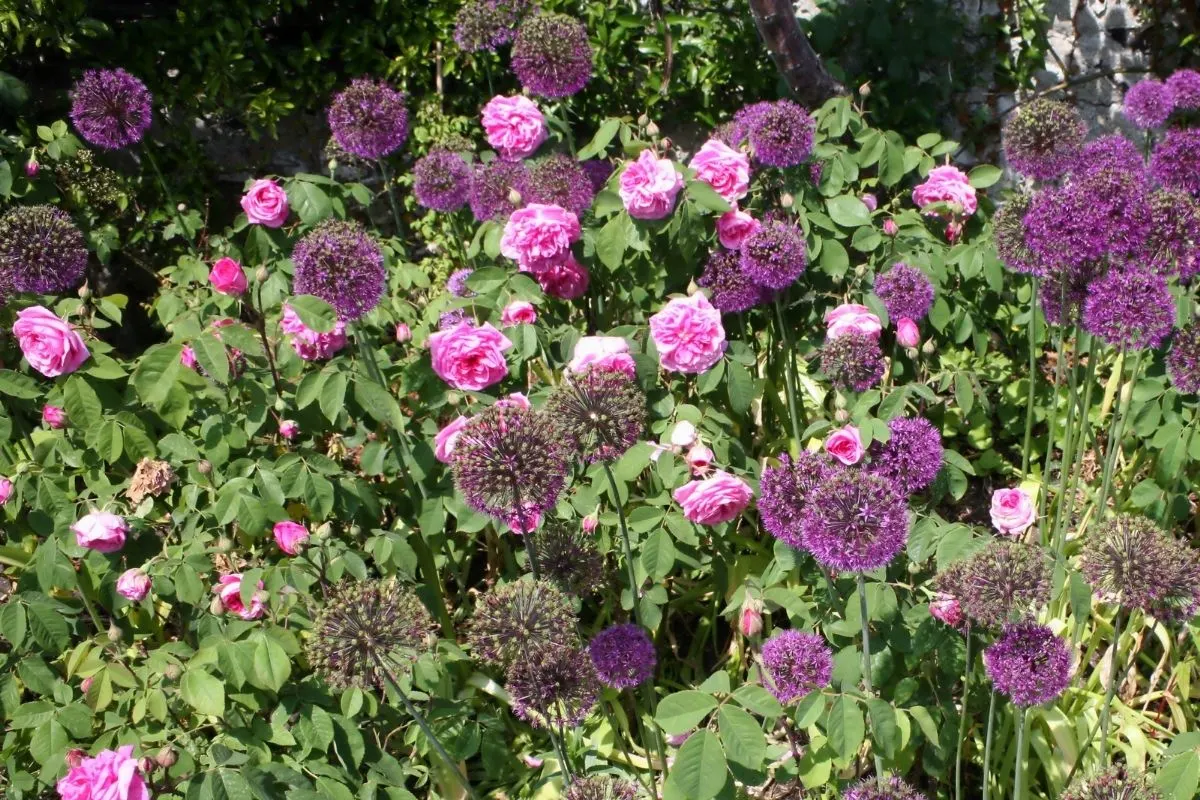
Alliums ward off aphids, carriers of fungal diseases such as black spot. Their pungent, sulfurous odors make the scents of roses stronger.
It’s not necessary to plant onions, garlic, chives, and shallots in your rose bed, although they would be helpful to the health of your roses. Violet, globe-like purple alliums look great with early-spring roses of light pink and white, and they come back on their own every year.
Just be aware of two potential problems in mixing alliums and roses:
- the tall spires of ornamental onions don’t always work with shrub roses.
- horticultural scientists have discovered that planting alliums and roses in the same bed reduces Japanese beetle infestations, but planting them in adjacent beds increases rose-loving Japanese beetle infestations. Planting members of the onion family in an adjacent bed will send beetles to the roses.
2. Clematis (Clematic spp.)
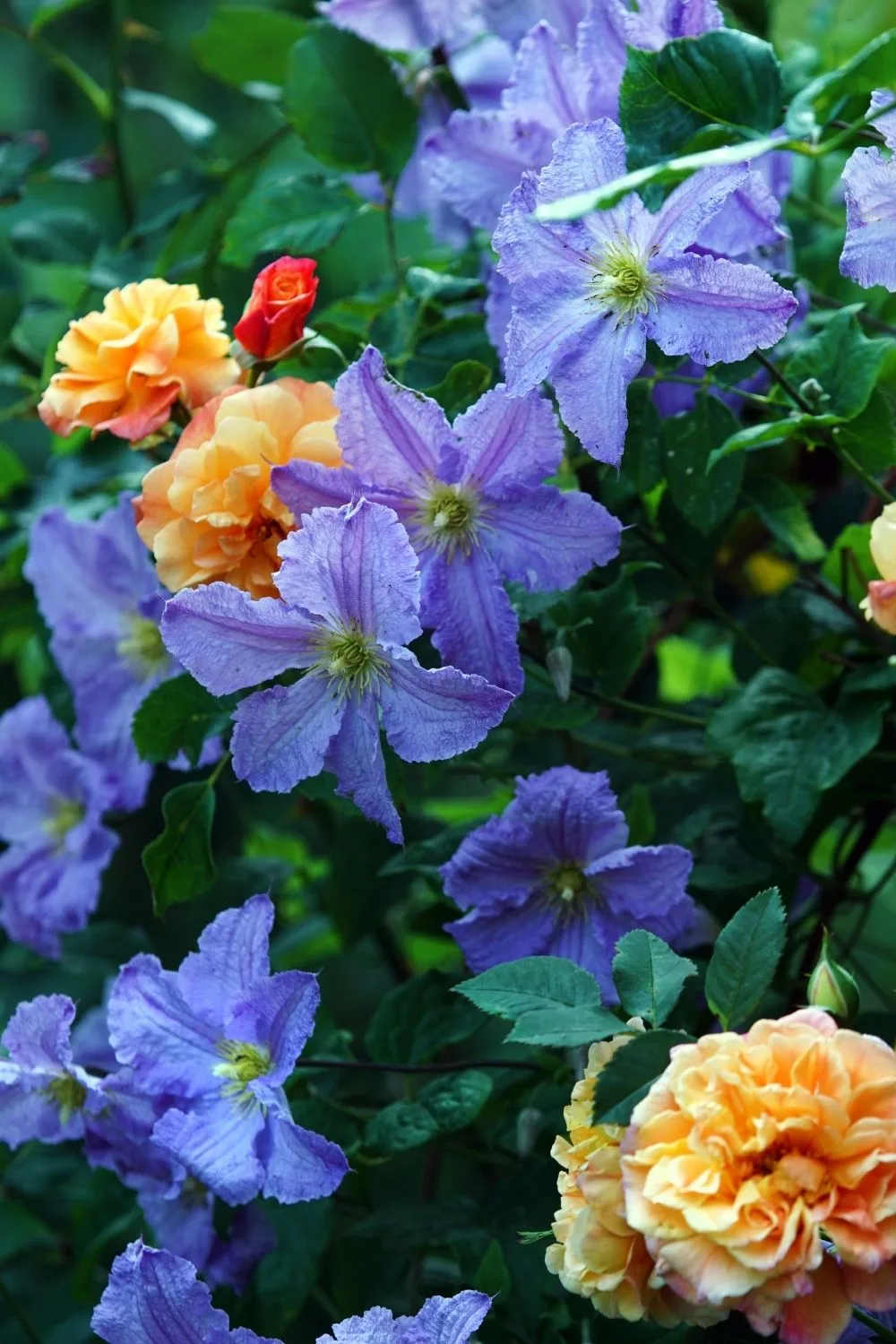
Late-blooming clematis makes a perfect planting partner for climbing roses, especially the rambling roses that bloom only once a year. Be sure to grow clematis on a pergola or arch. It can strangle a tree.
The clematis flowers attract birds that help with insect control.
A sweet pea planting can provide the same kind of visual contrast as clematis, without the danger of overrunning perennial plants.
3. Wallflower (Erysimum)
This perennial from the Cabbage family produces a group of chemicals known as cardenolides, which make butterflies resistant to predators. Its mildly poisonous leaves also deter rabbits and deer from rose and flower beds.
Erysimum blooms all year, providing a great foil for red, crimson, pink, or white roses.
4. Foxglove (Digitalis)
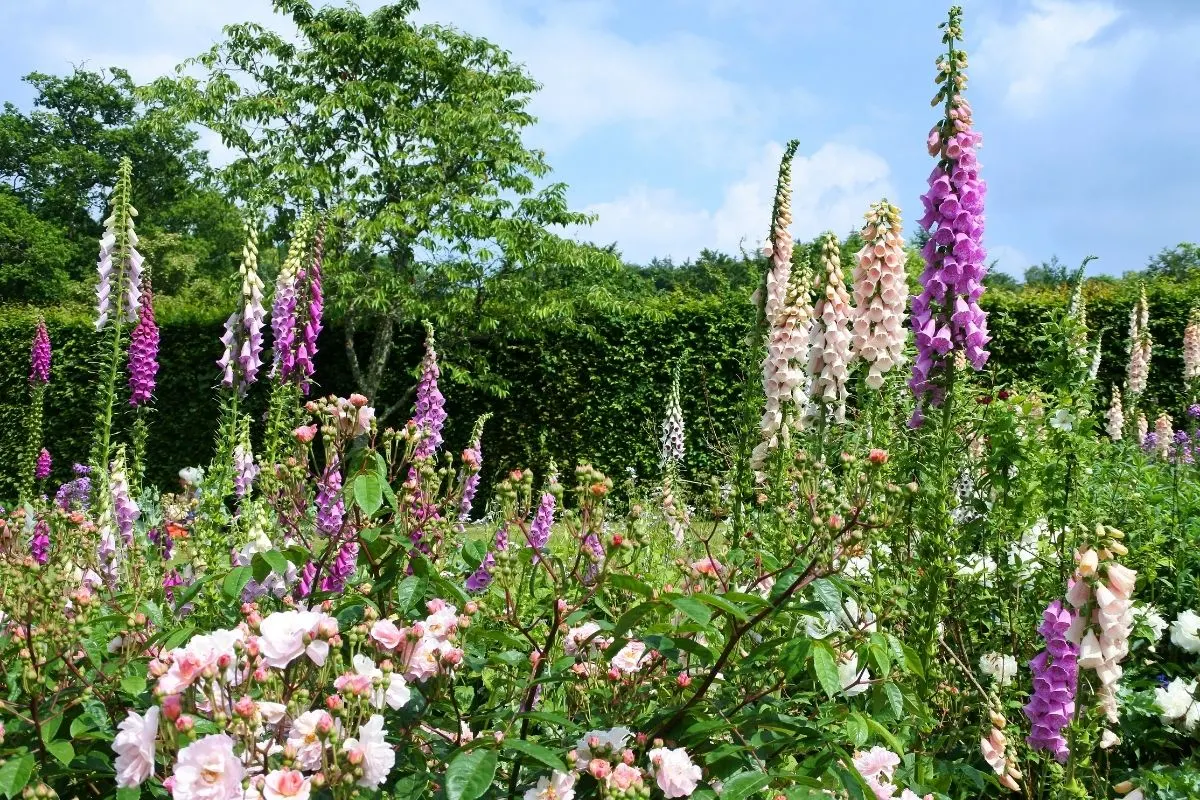
Pink, purple, and white foxgloves are in peak bloom in the middle of the summer when roses are not especially showy. A peach-colored foxglove called “Sutton’s Apricot” is especially lovely with crimson, pink, or cream-colored roses.
The problem with foxgloves is that they are susceptible to many of the same diseases as roses in rainy, humid weather, including mildew, aphids, mealybugs, and Japanese beetles. This makes them a suitable companion plant for roses only in dry-summer climates, since all of these pests can easily travel from foxgloves to roses planted nearby.
It’s also important to remember that foxgloves, also known as digitalis, can be toxic to pets and children.
5. Geraniums (Pelargonium)
Tiny, pink hardy geranium flowers look great as an underplant for roses.
Their essential oils repel mosquitoes (they cause digestive upset in Anopheles mosquitoes), blackflies, and gnats. Repelling blackflies and gnats stops the spread of black root blight, Botrytis blight, fusarium wilt, Pythium blight, and Verticillium wilt.
6. Lavender (Lavandula)
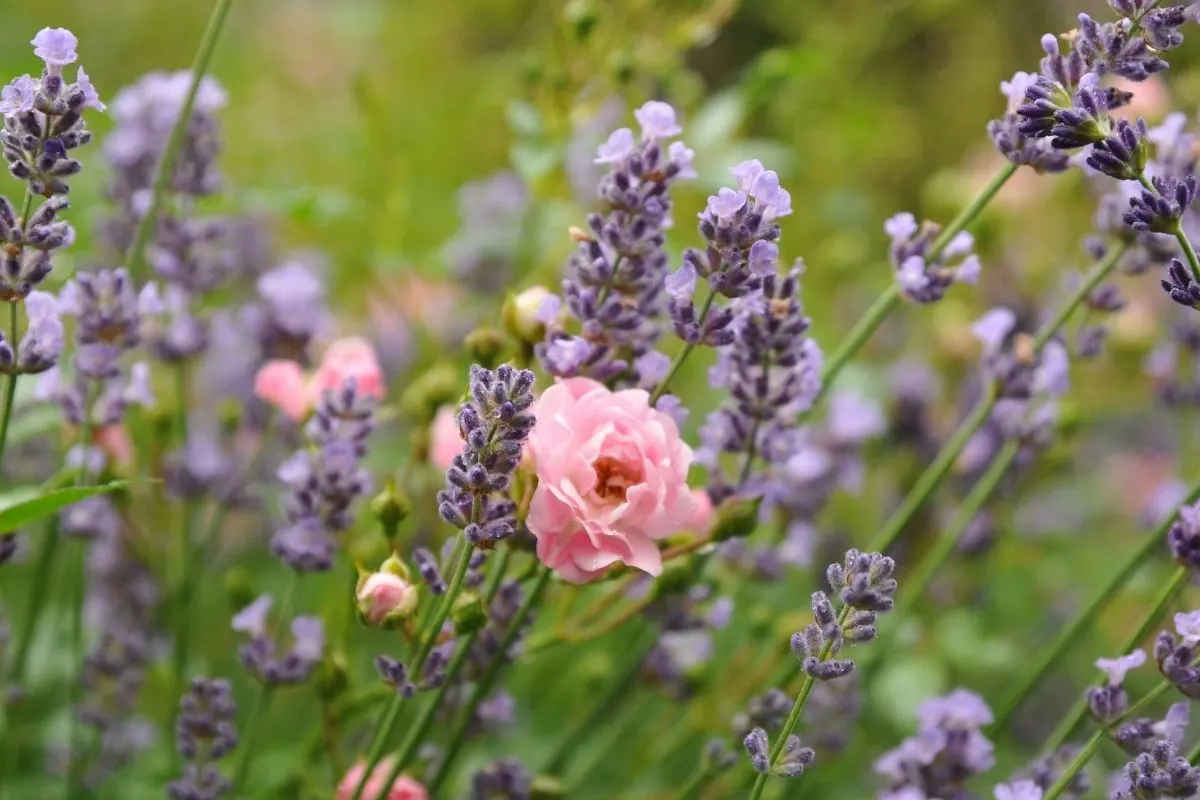
Do lavender and roses grow well together?
Lavender and roses make great neighbors but terrible roommates. Roses and lavender bloom at about the same time.
White roses and purple lavender can be visually attractive planted together. Their scents can be breathtaking. And the essential oils of lavender repel fleas, flies, and moths.
Just be sure to plant lavender and roses in separate beds, since lavender prefers slightly drier soil.
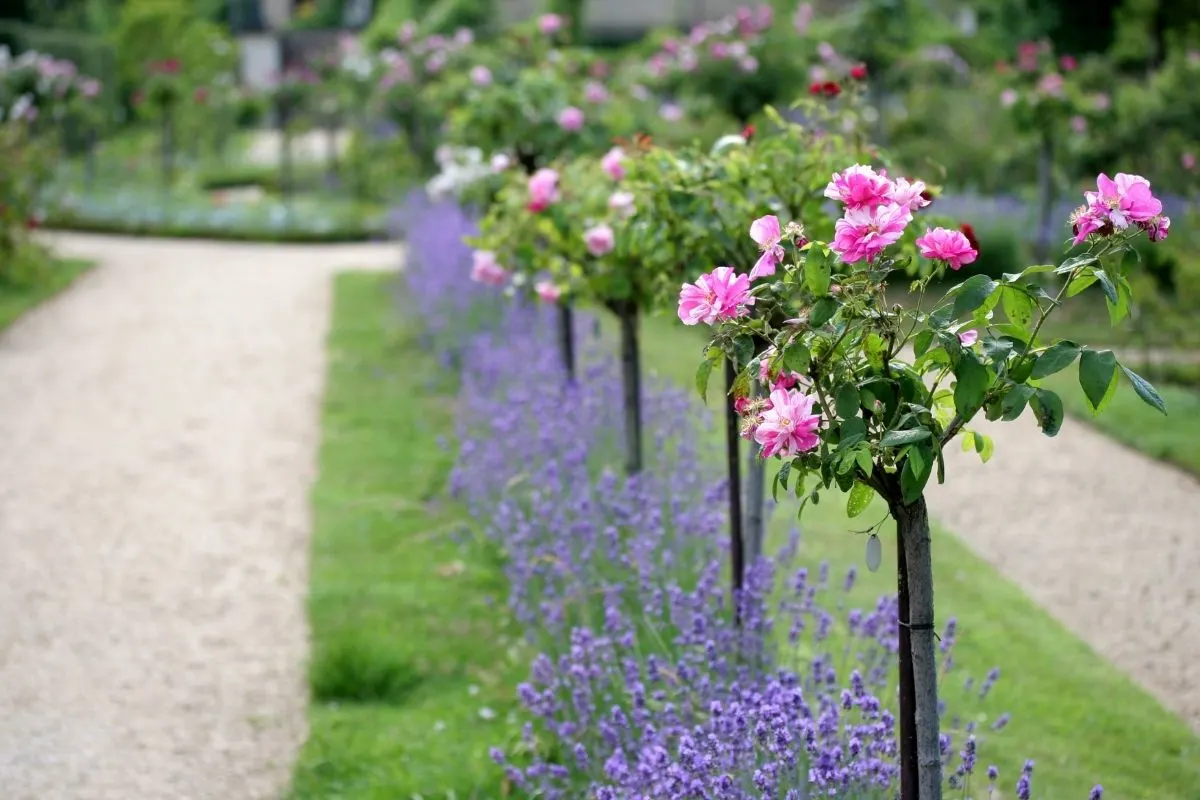
7. Lilies (Lilium)
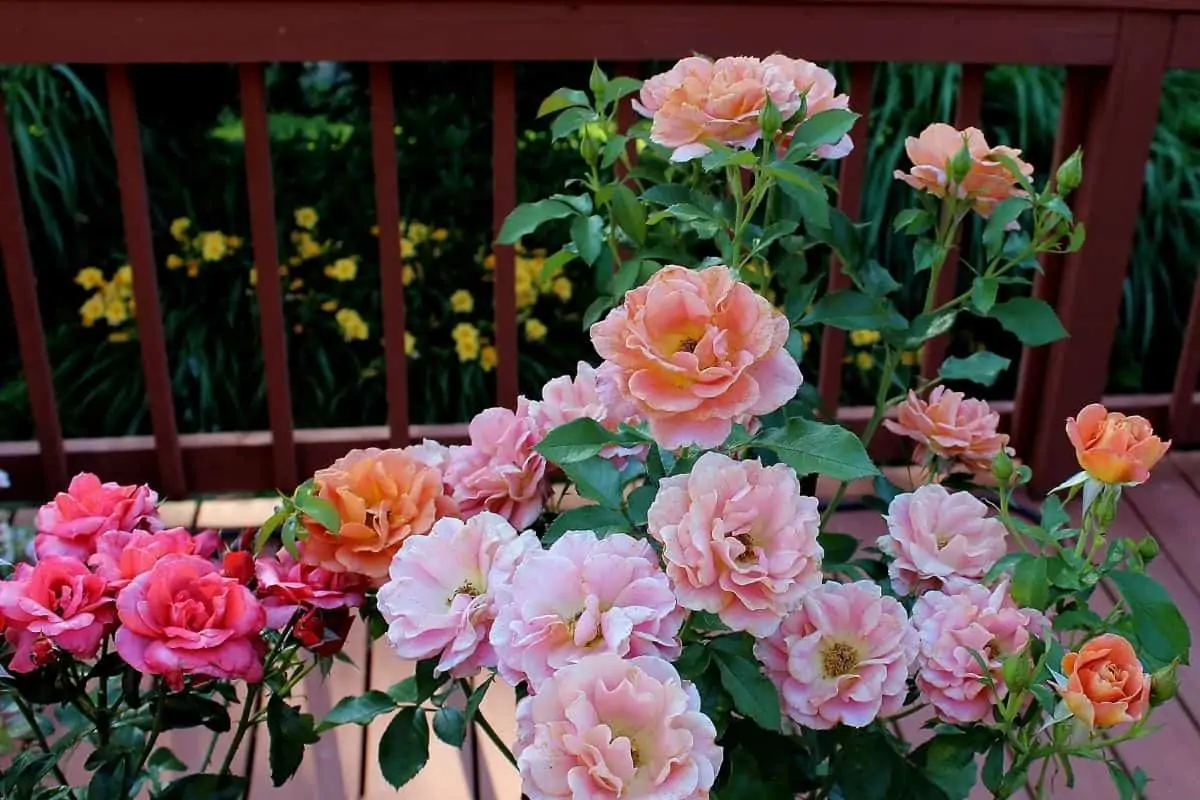
Lilies come into bloom just as the first flush of roses is coming to an end. They offer a different, delicious fragrance while rose buds are regenerating, and make good cut flowers.
Lilies are a decoy plant for beetles, as they attract beetles away from roses: kill the beetles on the lilies and your roses will be left undamaged. All parts of lilies, even the pollen, are toxic to dogs and cats and potentially fatal to puppies and kittens, so keep pets and lilies separate.
8. Catmint (Nepeta)
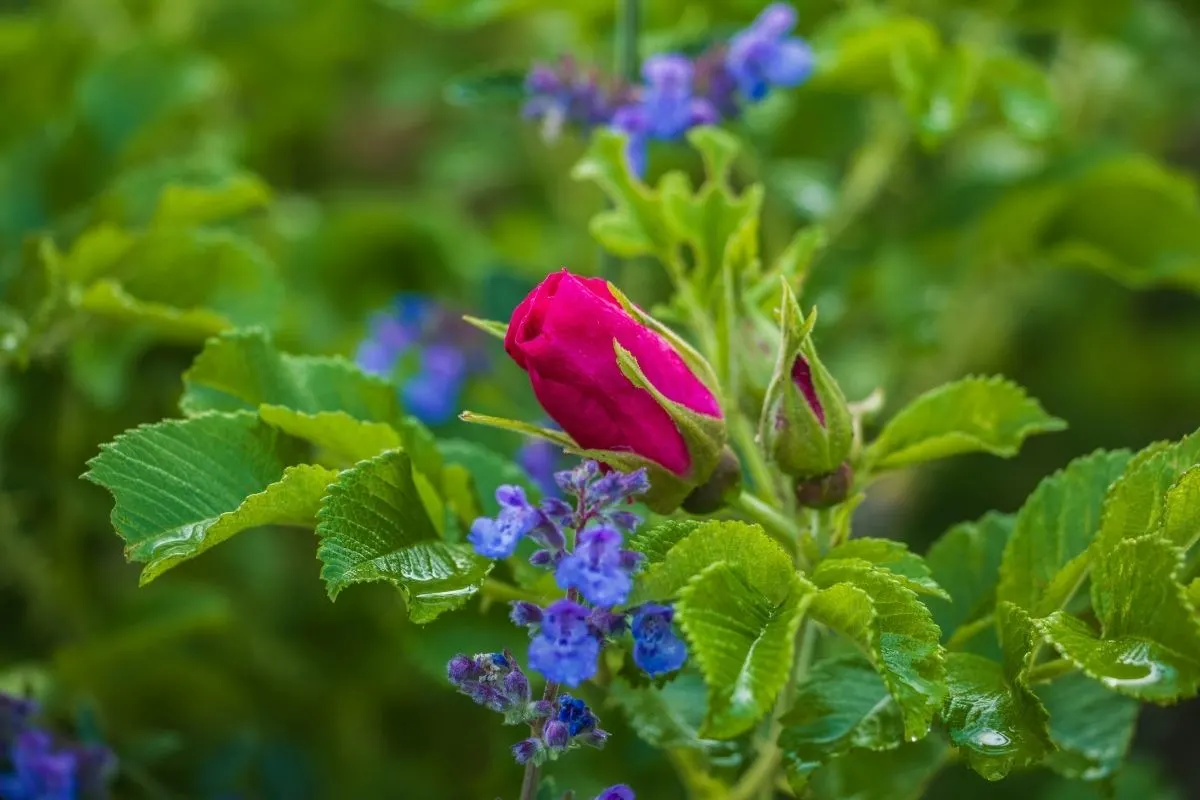
Nepeta makes a carpet of blue beneath rose bushes and attracts pollinators, including bees, butterflies, and hummingbirds.
9. Beardtongues (Penstemon)
Penstemons come in a variety of colors and shapes that add texture to your rose garden. Pink, crimson, purple, and white complement cream, apricot, and pink roses. Penstemons keep the show going after roses have stopped blooming, sometimes late into autumn.
Penstemons attract birds, beneficial insects, and butterflies but are resistant to deer and rabbits.
10. Sage (Salvia officinalis)
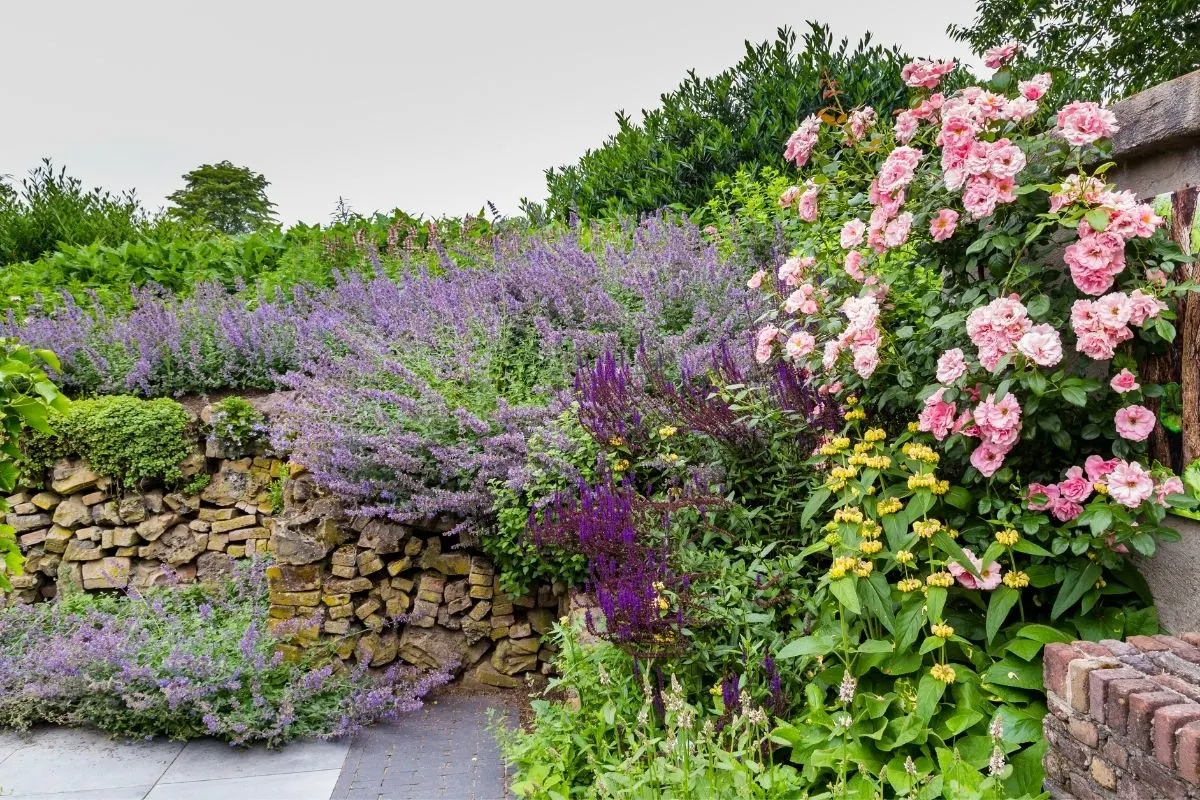
Salvias have spiral shapes that contrast the structure of roses, creating interest. They bloom most of the summer and come in a variety of colors. Many rose gardeners report that the hardy salvia helps keep blackspot and mildew at bay.
If you like the tall spikes of these flowers, you’ll also love pairing roses with Russian sage, a plant from the mint family, just like salvia.
11. Common mullein (Verbascum)
White, yellow, and peachy-orange mullein begin blooming in the middle of spring and are still going when roses come into bloom. They make a great casual border with poppies and tickseed. Verbascums repel cockroaches and moths.
FAQ about companion plants for roses
Here are some of the issues that come up in considering companion plants in rose gardens.
What should you not plant next to roses?
Roses don’t like to keep their feet wet. They shouldn’t be planted with companions that prefer or even require soggy soil, like irises and hardy ruellia (wild petunias).
There are also plants that repel insect pests away from themselves and to adjacent rose bushes. These include most kinds of citrus, all hot peppers, cedar, and mint.
Can roses grow under trees?
It’s never a good idea to plant roses under taller trees or shrubs. Roses need full sunlight and don’t do well in the shade.
The soil under nut-bearing trees is an especially bad location for roses. Walnuts, hickories, and some oaks release chemicals that kill all vegetation beneath them.
What grows under standard roses?
Some of the best companion plants for roses hide their bare legs. Nepeta (blue-gray catmint), lavender, and tall-growing pinks cover up long stems and also suppress weeds while keeping the soil moist and cool. For miniature roses, consider lamb’s ears.
Can roses and tomatoes be planted together?
Tomato plants repel blackspot, a major fungal pest of roses. You could plant roses and tomatoes in the same bed, but the aesthetic effect would be, well, odd. A better approach is to compost last year’s tomatoes and use them as fertilizer around this year’s roses.
What vegetables grow well with roses?
If you plan to plant vegetables with your roses, you’ll need to be careful not to spray your roses with anything that you wouldn’t want in your food. If you can stay away from the use of chemicals, there are some vegetables that would look great planted with roses. Plant a mixture of lettuces at the feet of the roses for both color and soil moisture control. Determinate tomatoes could do well, as well as some colorful hot peppers. You can also plant swiss chard, garlic, garlic chives, carrots, and even climbing beans on a trellis.
Can I plant herbs with roses?
Absolutely! Planting roses with the right companion plants will protect them from pests, and provide you with delicious aromatic plants for cooking. Consider planting herbs like culinary sage, thyme, lavender, basil, chamomile, and rosemary for a beneficial effect on your rose garden!
Conclusion for rose companion plants
There are some wonderful rose companions you can experiment with. Pick a combination that suits your taste, and gives you a flowering season from early spring through late summer and even into the fall. With so many good companion plants, you shouldn’t have a problem creating a beautiful garden.
